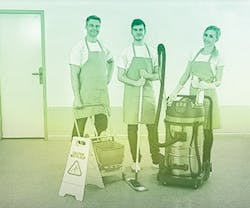You’ve already switched to natural cleaning formulas, recycled paper towels, microfiber cloths and products that have minimal packaging – so now what? Take a look at your cleaning machines. This equipment can reduce energy and water consumption, support indoor air quality and protect workers from injury.
Vet Your Vacuums
Vacuums should be effective at removing dirt from carpet without contaminating the air with particles. Look for models that are Seal of Approval/Green Label certified by the Carpet and Rug Institute (CRI). This program ensures that vacuums maintain high soil removal, won’t damage the pile and keep dust locked into the chamber. CRI also offers a separate certification for carpet extraction equipment. “HEPA-like filters improve indoor air quality, and disposable, sealable bags are essential to contain the particulate during bag replacement,” adds Gary Tourre, Senior Sales Technical Trainer for Staples.
Particularly with the rise in day cleaning, machines shouldn’t create noise pollution for workers or put users at risk of hearing damage. Under the LEED category for the High Performance Green Cleaning Program (EQ3.1), the credit recommends that vacuums “operate with a sound level of less than 70 dBA (A-weighted decibels).”
If your facility has large expanses of carpet, using a vacuum “with variable power levels will reduce energy consumption as well as lower sound levels,” Tourre notes.
Straighten Up Scrubbers
Scrubbers don’t need to use excessive amounts of product, water or power to get your floors to sparkle. Tourre recommends “an optional precise dosing system to minimize the use of cleaning chemicals. Foam-activated scrubbing systems and electrically converted water systems can further reduce the need for chemicals.” It’s also possible to use plain tap water if soiling is light.
“Orbital scrubbers with rectangular heads minimize the amount of chemicals and water needed,” Tourre adds. “Floor pads for both orbital and disc-type machines eliminate the use of chemicals to remove floor finish as well.”
If you have propane-powered equipment, LEED recommends models that have “high-efficiency, low-emissions engines with catalytic converters and mufflers that meet the California Air Resources Board (CARB) or EPA standards for that engine size.” These should likewise operate under 90 dBA. Points are also available for automated scrubbers with variable-speed feed pumps.
Elevate Ergonomics
Green cleaning is so much more than the type of soap or machines you use. Your maintenance staff deserves to complete their tasks without the risk of injury. “Ergonomic equipment reduces back strain, repetitive stress injuries and other ailments caused by manual methods,” stresses Tourre. The LEED EQ3.1 language also emphasizes that “powered equipment [should be] ergonomically designed to minimize vibration, noise and user fatigue.”
For wand tools, like dusters or brushes, “adjustable handles that consider the operator’s height are helpful in reducing hand and wrist injuries,” says Tourre. Budget permitting, upgrading from walk-behind to ride-on equipment is also better for operators because it reduces fatigue and accidents. As an added bonus, Tourre adds, riding machines can also increase productivity by up to 40%.
About the Author
Jennie Morton
A former BUILDINGS editor, Jennie Morton is a freelance writer specializing in commercial architecture, IoT and proptech.
